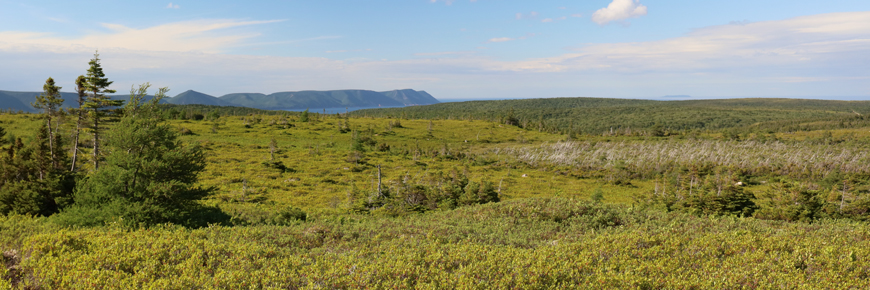
Taiga region
Cape Breton Highlands National Park
The taiga forest region is made up of scrub forest, extensive stretches of boggy wetlands and rocky barrens above 400 metres. Cape Breton Highlands National Park protects nearly 75% of the taiga in the northern Cape Breton ecosystem.
Barren but beautiful
The dwarfed vegetation of this forest region resembles the transitional softwood forests of northern Canada. A short growing season, exposure to ice and snow blasting, extreme temperatures and thin soils deform and stunt the trees. Shrubby black spruce are characteristic of the Taiga and may be much older than they look - trees only a metre tall have been aged at 150 years old! Typical plants of the dry barrens are reindeer lichens, blueberry and sheep laurel. The bogs are home to sphagnum moss, cotton grass, rushes, small orchids, cranberry, and Labrador tea as well as a few insect-eating plants such as the sundew and the pitcher plant.
The taiga is used to some extent by moose, black bears and a few other mammals, mainly for feeding during the warmer months. Birds such as the Bicknell's thrush and greater yellowlegs breed in the taiga. The taiga with its standing water is a haven for insects and other invertebrates.
Born in fire, sculpted by weather
The taiga of northern Cape Breton may have had its origin in fire in the late 1700s or earlier. It is possible that at one time, the barrens of the taiga were covered with balsam fir and were just an extension of the boreal forest onto the plateau. Then fire struck, burning down the trees. The harsh climate and poor soil conditions of the plateau may have prevented or slowed down the usual succession of the boreal forest. The low, tundra-like vegetation and dwarfed trees persist, giving rise to the taiga.
The shrubs and ground cover in the taiga give the illusion that the land is perfectly smooth from a distance, but walking through the taiga, it is obvious that the land is actually very uneven and hummocky. The height of the shrubs and trees is determined by snow depth and wind - snow cover insulates the vegetation from the bitter winter winds. Any shoots that protrude above the snow cover usually die off from ice blasting. In effect, the shrubs and trees of the taiga are naturally pruned by the weather. Because of this pruning effect, in some areas tangled, ground-hugging mats of black spruce and balsam fir called "krummholz" occur.
In some parts of the taiga, prevailing winds during the rest of the year create lopsided trees and shrubs. The cold wind damages or kills growth on the side of the tree the wind encounters first. The tree's leeward side is protected from the wind and so remains relatively undamaged.
- Date modified :